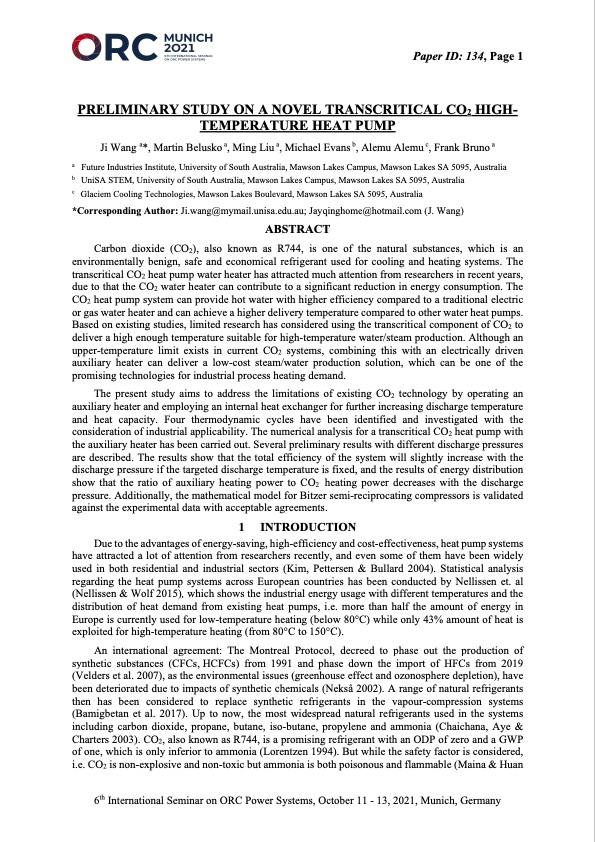
PDF Publication Title:
Text from PDF Page: 001
a b c PRELIMINARY STUDY ON A NOVEL TRANSCRITICAL CO2 HIGH- TEMPERATURE HEAT PUMP Ji Wang a*, Martin Belusko a, Ming Liu a, Michael Evans b, Alemu Alemu c, Frank Bruno a Future Industries Institute, University of South Australia, Mawson Lakes Campus, Mawson Lakes SA 5095, Australia UniSA STEM, University of South Australia, Mawson Lakes Campus, Mawson Lakes SA 5095, Australia Glaciem Cooling Technologies, Mawson Lakes Boulevard, Mawson Lakes SA 5095, Australia *Corresponding Author: Ji.wang@mymail.unisa.edu.au; Jayqinghome@hotmail.com (J. Wang) ABSTRACT Carbon dioxide (CO2), also known as R744, is one of the natural substances, which is an environmentally benign, safe and economical refrigerant used for cooling and heating systems. The transcritical CO2 heat pump water heater has attracted much attention from researchers in recent years, due to that the CO2 water heater can contribute to a significant reduction in energy consumption. The CO2 heat pump system can provide hot water with higher efficiency compared to a traditional electric or gas water heater and can achieve a higher delivery temperature compared to other water heat pumps. Based on existing studies, limited research has considered using the transcritical component of CO2 to deliver a high enough temperature suitable for high-temperature water/steam production. Although an upper-temperature limit exists in current CO2 systems, combining this with an electrically driven auxiliary heater can deliver a low-cost steam/water production solution, which can be one of the promising technologies for industrial process heating demand. The present study aims to address the limitations of existing CO2 technology by operating an auxiliary heater and employing an internal heat exchanger for further increasing discharge temperature and heat capacity. Four thermodynamic cycles have been identified and investigated with the consideration of industrial applicability. The numerical analysis for a transcritical CO2 heat pump with the auxiliary heater has been carried out. Several preliminary results with different discharge pressures are described. The results show that the total efficiency of the system will slightly increase with the discharge pressure if the targeted discharge temperature is fixed, and the results of energy distribution show that the ratio of auxiliary heating power to CO2 heating power decreases with the discharge pressure. Additionally, the mathematical model for Bitzer semi-reciprocating compressors is validated against the experimental data with acceptable agreements. 1 INTRODUCTION Due to the advantages of energy-saving, high-efficiency and cost-effectiveness, heat pump systems have attracted a lot of attention from researchers recently, and even some of them have been widely used in both residential and industrial sectors (Kim, Pettersen & Bullard 2004). Statistical analysis regarding the heat pump systems across European countries has been conducted by Nellissen et. al (Nellissen & Wolf 2015), which shows the industrial energy usage with different temperatures and the distribution of heat demand from existing heat pumps, i.e. more than half the amount of energy in Europe is currently used for low-temperature heating (below 80°C) while only 43% amount of heat is exploited for high-temperature heating (from 80°C to 150°C). An international agreement: The Montreal Protocol, decreed to phase out the production of synthetic substances ( environmental issues (greenhouse effect and ozonosphere depletion), have been deteriorated due to impacts of synthetic chemicals (Nekså 2002). A range of natural refrigerants then has been considered to replace synthetic refrigerants in the vapour-compression systems (Bamigbetan et al. 2017). Up to now, the most widespread natural refrigerants used in the systems including carbon dioxide, propane, butane, iso-butane, propylene and ammonia (Chaichana, Aye & Charters 2003). CO2, also known as R744, is a promising refrigerant with an ODP of zero and a GWP of one, which is only inferior to ammonia (Lorentzen 1994). But while the safety factor is considered, i.e. CO2 is non-explosive and non-toxic but ammonia is both poisonous and flammable (Maina & Huan Paper ID: 134, Page 1 CFCs, HCFCs) from 1991 and phase down the import of HFCs from 2019 (Velders et al. 2007), as the 6th International Seminar on ORC Power Systems, October 11 - 13, 2021, Munich, GermanyPDF Image | NOVEL TRANSCRITICAL CO2 HIGH- TEMPERATURE HEAT PUMP

PDF Search Title:
NOVEL TRANSCRITICAL CO2 HIGH- TEMPERATURE HEAT PUMPOriginal File Name Searched:
1633140.pdfDIY PDF Search: Google It | Yahoo | Bing
CO2 Organic Rankine Cycle Experimenter Platform The supercritical CO2 phase change system is both a heat pump and organic rankine cycle which can be used for those purposes and as a supercritical extractor for advanced subcritical and supercritical extraction technology. Uses include producing nanoparticles, precious metal CO2 extraction, lithium battery recycling, and other applications... More Info
Heat Pumps CO2 ORC Heat Pump System Platform More Info
| CONTACT TEL: 608-238-6001 Email: greg@infinityturbine.com | RSS | AMP |